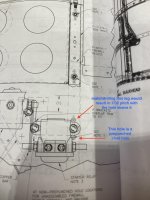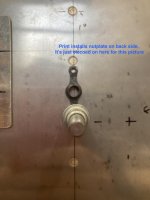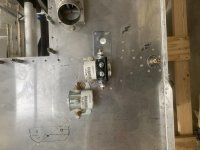Desert Rat
Well Known Member
Hey guys- I was laying out the contactors this afternoon, and ran into something odd.
Per print, the most inboard nut plate picks up an existing rivet hole for the lower leg and then you're supposed to match drill thru the upper leg, but that would put the hole way below min. rivet spacing per mil-spec with the next rivet up in the run. This row of rivets goes through the firewall, then the vertical angle behind which ties in to lost of other important stuff, so it's kind of a big deal
I know that manufacturing engineering take precedence over mil-spec, and I've given that advise myself, but this just doesn't look right. If I drill it per print, there will only be about 7/32 center to center between these 2 rivets, which is less that 1/2 the Mil-Spec requirement.
I'm inclined to just skip the nutplate, put a nut on the back side, and live with the fact that if it ever dies on the road, swapping it will be a two person job. But, I looked at a lot of build logs online and I see that a bunch of people have just lived with how this turns out.
I'm curious if anybody has talked to Van's about it?
Per print, the most inboard nut plate picks up an existing rivet hole for the lower leg and then you're supposed to match drill thru the upper leg, but that would put the hole way below min. rivet spacing per mil-spec with the next rivet up in the run. This row of rivets goes through the firewall, then the vertical angle behind which ties in to lost of other important stuff, so it's kind of a big deal
I know that manufacturing engineering take precedence over mil-spec, and I've given that advise myself, but this just doesn't look right. If I drill it per print, there will only be about 7/32 center to center between these 2 rivets, which is less that 1/2 the Mil-Spec requirement.
I'm inclined to just skip the nutplate, put a nut on the back side, and live with the fact that if it ever dies on the road, swapping it will be a two person job. But, I looked at a lot of build logs online and I see that a bunch of people have just lived with how this turns out.
I'm curious if anybody has talked to Van's about it?







